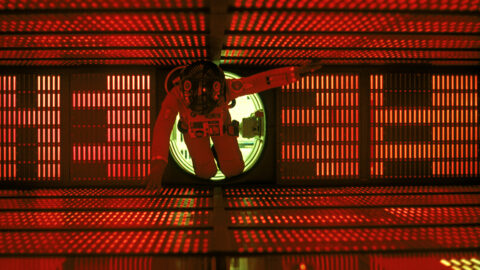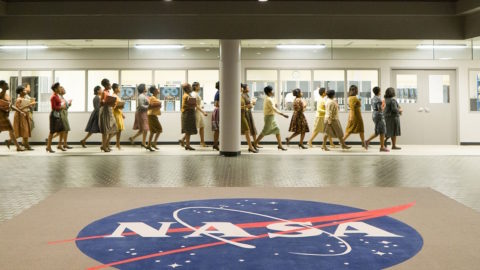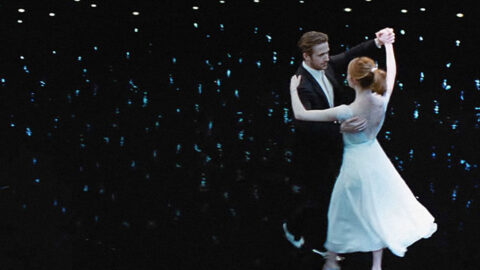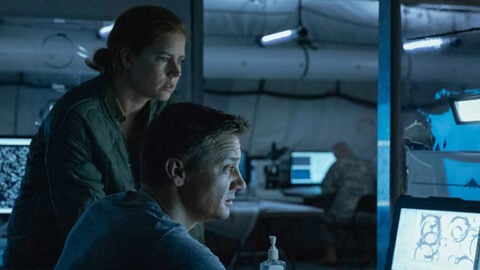Deep Focus: First Man

I assume the title The Best Man wasn’t used because it was already taken. In their hagiographic portrayal of astronaut Neil Armstrong, director Damien Chazelle, screenwriter Josh Singer, and star Ryan Gosling depict him as the perfect—no, the only—choice to be the first man on the moon. He’s inherently modest and self-effacing; he’s all about putting the Gemini and Apollo programs first and letting actions speak for themselves. We’re made to understand that Armstrong’s emotional struggle with the cancer death of his and Janet’s two-year-old daughter Karen not only colored all his relationships but also drove him to achieve excellence when he joined NASA in 1962. It’s as if Orson Welles identified Rosebud as Kane’s sled from the beginning and tried to make us sob when it went up in flames at the end. Karen’s loss leads Armstrong to shed tears only in the privacy of his study, or, more cathartically, on the moon.
Chazelle and Singer have created a grueling, prosaic, state-of-the-art docudrama (no imagination allowed) with the heart of a male weepie. And Gosling has responded with a virtuosic display of sensitive-guy emotions, so even when he’s infuriatingly recessive with his wife Janet (Claire Foy)—and she must force him to give his sons Rick and Mark (Luke Winters and Connor Blodgett) a meaningful goodbye before his Apollo XI mission—we’re encouraged to feel as if no one could be suffering more nobly.
The movie’s aesthetic strategy is to pit this latest incarnation of the strong, silent type against noise: the hum of bureaucratic friction and the metallic din raised by high-speed planes, capsules, and rockets as they tear through Earth’s thin atmosphere and battle its gravitational pull. First Man starts with a black screen and a low rumble that becomes a racket when Armstrong’s X-15 spaceplane detaches from a B-52 and he lights its rocket, rising to the suborbital realm of 140,000 feet, where he sees a pencil become weightless and float before his eyes. Chazelle puts us in the cockpit as he wrestles with Mach 5 speeds and thrust, dividing our vision between this tiny compartment and the slivers of the wild blue yonder he glimpses through his windshields. We’re right at Armstrong’s side as he strives to take the X-15 down from its top height, while we hear phrases crackling over the radio, like “ballooning” and “bouncing off the atmosphere,” and Neil saying he’ll lower “the angle of attack to decrease the speed.” Since we don’t have the training or knowledge to comprehend the action, from the beginning the movie blunts our senses instead of opening them up—we either go on up Space Mountain, or close our eyes, cover our ears, and check when it’s over.
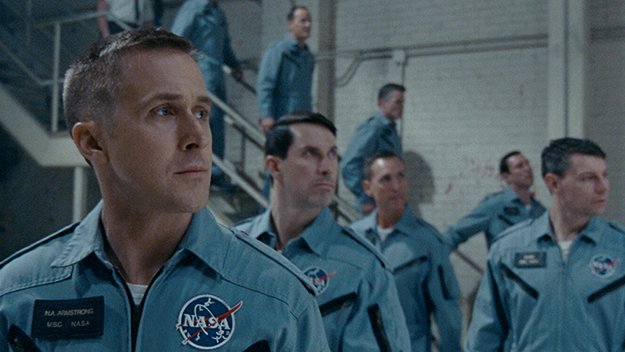
With so many quaking images and blaring sounds set off by abrupt and ominous stillness, it’s impossible for us to grasp the aerial techniques or scientific principles behind what’s happening. We don’t learn enough about them even after—spoiler alert—Armstrong makes it safely to the ground. All we comprehend is that Armstrong has taken three bad X-15 flights during the period of his daughter’s terminal illness: “Kid’s a good engineer, but he’s distracted,” says Chuck Yeager (Matthew Glave), in his one brief appearance. Armstrong’s string of near-disasters, along with Karen’s death, propel him to apply for the Gemini program, which Janet says will be “a fresh start.” For them maybe, not for the movie.
This film is the work of A-plus students aiming to satisfy Armstrong’s official biographer, Jim Hansen (author of the book First Man), Armstrong’s sons, and NASA itself, which cooperated with the filming. In the film’s press notes, one producer suggests that the sober behavior of the Gemini and Apollo astronauts represents a generational shift from the “swagger” of the Mercury astronauts. But Hansen is adamant that Armstrong and his closest friends represent “The Real Right Stuff.” (In a slap at Tom Wolfe’s book and Philip Kaufman’s movie, Hansen gives that title to one of his book’s eight sections.) And the filmmakers pride themselves on staying close to Hansen’s meticulously researched biography. But authorized biographers and their sources have their own agendas, and bringing irreverent perspectives to official history, as Wolfe and Kaufman did, can revitalize hackneyed narratives and find fresh truths in them. Chazelle’s determination to tell the movie not just from Armstrong’s solemn point of view, but also from Hansen’s earnest-worshipful depiction of it, makes for a literal, one-note movie. It never stops trying to impress us with its knock-your-socks-off brand of mimesis. Chazelle loosens his grip only when the screen expands to IMAX as Armstrong and Buzz Aldrin (Corey Stoll) alight on the moon. By then, I felt relief more than emotional lift or spiritual uplift. Chazelle doesn’t even try for poetry. On the moon, he engineers the big moments to wipe us out emotionally as Armstrong finally gets to purge his guilt and sorrow over Karen’s death.
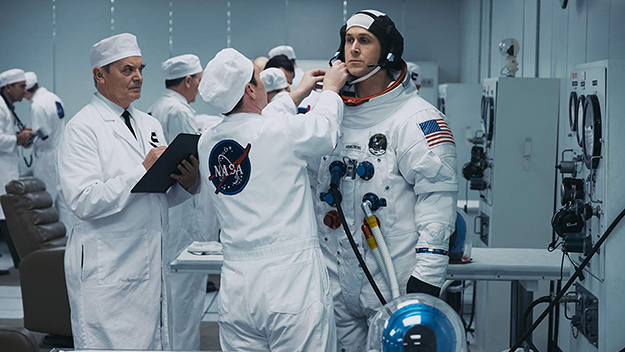
Chazelle sets out to create an ultra-visceral hyper-realism. Despite obvious nods to Kaufman and Stanley Kubrick (2001: A Space Odyssey), what he arrives at is plodding and dramatically opaque. For me the experience resembles, in its hyped and contrast-ridden style, watching John Krasinski’s horror movie A Quiet Place at a “4D” theater in which my seat rocked and, in the non-quiet moments, the sound effects were amped (as Matt Damon’s SNL Brett Kavanaugh would say) to “start at an 11” and “take it to about a 15 real quick.” Even if it’s Armstrong’s chassis that’s shaking, not the 4D seating, Chazelle’s idea of “immersive cinema” is equally mechanical. As tons of mediocre action films have proven over the last three decades, some audiences love being pummeled. The “shaky-cam,” which made its comeback in coffee-commercials in the 1990s, became so mainstream-acceptable in the Bourne movies that it’s hard to find a film about people in duress that doesn’t overuse it, including First Man. Because of its conventionality, Chazelle might end up with a hit—action fans may find its high tone refreshing while for some devotees of “prestige” drama, the dynamic clichés will seem brand-new. Although the movie has triggered a bogus controversy for skipping the moment when Armstrong and Aldrin actually planted the flag on the moon (we see it clearly enough afterwards), it’s eminently square. It could appeal both to those America Firsters who remember when it was patriotic to best the Russians and to those independents and progressives who yearn to restore national heroism based on idealistic deeds instead of offensive bluster.
It becomes a Great Man movie partly by default. Singer’s script fails to do what he and co-writer/director Tom McCarthy did so triumphantly in Spotlight: invest each member of a sprawling ensemble with a distinct personality. Because of the size and force of her talent, Claire Foy is able to infuse Janet with a hot-wire presence. Foy’s incisive attack jolts her scenes to life. Her playfulness and irony animate a few lighthearted interludes, whether she’s dancing with her husband to the odd theremin sounds of “Lunar Rhapsody” (from the fluke-hit album Music Out of the Moon) or revealing to other astronaut couples that he was a musical-comedy freak who wrote new lyrics to Gilbert & Sullivan songs for an undergraduate musical: The Land of Egelloc (college spelled backward). Her emotional transparency lets us feel the mixtures of frustration, tenderness, and passion triggered by Janet’s distant and confounding man. Yet the climactic sight of them touching hands to opposite sides of a glass wall during his post-flight quarantine feels skimpy and unearned—a bland heir to Nigel Patrick and Ann Todd rubbing oxygen masks in David Lean’s Breaking the Sound Barrier.
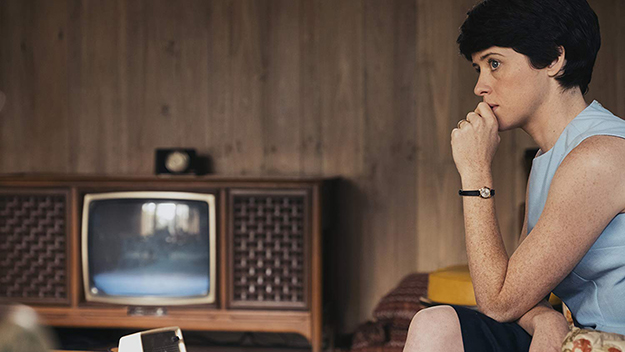
As for the male characters, whether it’s Jason Clarke as Ed White, Kyle Chandler as Deke Slayton, Lukas Haas as Michael Collins, or Patrick Fugit as Elliott See, the direction reduces them to empty suits or spacesuits. The director believes in putting singular actors in supporting roles, but he lacks the teeming imagination of a Kaufman or Peckinpah to mold them into a vibrant kinetic tapestry. Stoll’s Aldrin provides the jauntiest contrast to Armstrong: Singer writes him and Stoll plays him as an uninhibited truth-teller. But Chazelle sets up his early scenes to make him look like a jerk. When the astronauts gather for a wake after See and Charlie Bassett die in a plane crash, Aldrin blames See, who was piloting, while Armstrong defends his late friend and everyone else looks on aghast. The group shames Aldrin for following a tradition celebrated in pioneer aviation films like Victor Fleming’s Test Pilot and Howard Hawks’s Only Angels Have Wings: talking straight with fellow airmen about an aviator who made a mistake or wasn’t up to a task, no matter how compassionately and generously one might remember the person in private. Something inherently Manichean in Chazelle’s sensibility makes him position Aldrin as Armstrong’s total opposite and thus a bit of a buffoon.
Without Aldrin and Foy, this celebration of small-town values would be strictly Dullsville. Gosling wrings a few laughs from Armstrong’s understatement, but he’s generally content to become a model of beautiful misery and sober-sided gallantry. Within the film’s narrow conception of Armstrong’s character, Gosling never makes an ostentatious move. It comes off as a rare feat of modesty and talent, until you realize that this film does all the humble-bragging for him.
Michael Sragow is a contributing editor to Film Comment and writes its Deep Focus column. He is a member of the National Society of Film Critics and the Los Angeles Film Critics Association, and a contributor to the Criterion Collection.



